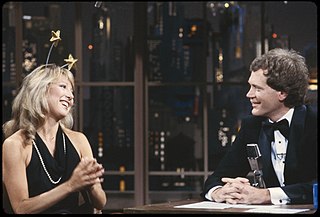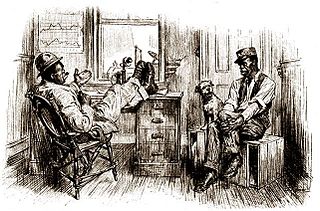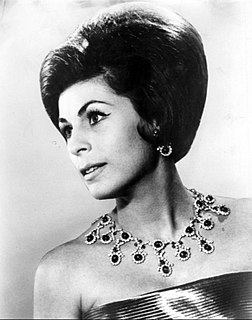
A talk show is a television programming or radio programming genre structured around the act of spontaneous conversation. A talk show is distinguished from other television programs by certain common attributes. In a talk show, one person discusses various topics put forth by a talk show host. This discussion can be in the form of an interview or a simple conversation about important social, political or religious issues and events. The personality of the host shapes the tone of the show, which also defines the "trademark" of the show. A common feature or unwritten rule of talk shows is to be based on "fresh talk", which is talk that is spontaneous or has the appearance of spontaneity.
The year 1971 involved some significant events in television. Below is a list of notable TV-related events.
The year 1962 involved some significant events in television. Below is a list of notable events of that year.

Amos 'n' Andy is an American radio sitcom about black characters, initially set in Chicago and later in the Harlem section of New York City. While the show had a brief life on 1950s television with black actors, the 1928 to 1960 radio show was created, written and voiced by two white actors, Freeman Gosden and Charles Correll, who played Amos Jones (Gosden) and Andrew Hogg Brown (Correll), as well as incidental characters. On television, 1951–1953, black actors took over the majority of the roles; white characters were infrequent.
Live television is a television production broadcast in real-time, as events happen, in the present. In a secondary meaning, it may refer to streaming television over the Internet when content or programming is played continuously. For example, the Pluto TV app has two categories for viewing: "Live TV" & "On Demand." On its website, Xfinity states "Watch TV series and top rated movies live and on demand with Xfinity Stream."
The Gillette Cavalcade of Sports is an American radio-turned-television program by the National Broadcasting Company (NBC) that ran from 1942 to 1960. The program included broadcasts of a variety of sports, although it is primarily remembered for its focus on boxing matches.
The following is the 1985–86 network television schedule for the three major English language commercial broadcast networks in the United States. The schedule covers primetime hours from September 1985 through August 1986. The schedule is followed by a list per network of returning series, new series, and series cancelled after the 1984–85 season. All times are Eastern and Pacific, with certain exceptions, such as Monday Night Football.

The Red Skelton Show is an American television comedy/variety show that aired from 1951 to 1971. In the decade prior to hosting the show, Richard "Red" Skelton had a successful career as a radio and motion pictures star. Although his television series is largely associated with CBS, where it appeared for more than sixteen years, it actually began and ended on NBC. During its run, the program received three Emmy Awards, for Skelton as best comedian and the program as best comedy show during its initial season, and an award for comedy writing in 1961. In 1959 Skelton also received a Golden Globe for Best TV Show.

Roberta Peters was an American coloratura soprano.

Amahl and the Night Visitors is an opera in one act by Gian Carlo Menotti with an original English libretto by the composer. It was commissioned by NBC and first performed by the NBC Opera Theatre on December 24, 1951, in New York City at NBC Studio 8H in Rockefeller Center, where it was broadcast live on television from that venue as the debut production of the Hallmark Hall of Fame. It was the first opera specifically composed for television in the United States.
The Liberty Broadcasting System was a U.S. radio network of the late 1940s and early 1950s founded by Gordon McLendon, which mainly broadcast live recreations of Major League Baseball games, by following the action via Western Union ticker reports. The sound effects were very realistic, and many listeners were not aware the broadcasters were not announcing the action live. At that time some major league teams and almost all minor league baseball clubs used recreations of their road games as an economy measure.

The CBS Late Movie is a CBS television series during the 1970s and 1980s. The program ran in most American television markets from 11:30 p.m. (ET/PT) until 2:30 a.m. or later, on weeknights. A single announcer voiced the introduction and commercial bumpers for each program, but there was no host per se, or closing credits besides those of the night's presentation.
James Robert Forrest Jr. was an American jazz musician, who played tenor saxophone throughout his career.

An anthology series is a radio, television, video game or film series that spans different genres and presents a different story and a different set of characters in each different episode, season, segment, or short. These usually have a different cast in each episode, but several series in the past, such as Four Star Playhouse, employed a permanent troupe of character actors who would appear in a different drama each week. Some anthology series, such as Studio One, began on radio and then expanded to television.
The following is the 1951–52 network television schedule for the four major English language commercial broadcast networks in the United States. The schedule covers primetime hours from September 1951 through March 1952. The schedule is followed by a list per network of returning series, new series, and series cancelled after the 1950–51 season. This was the first television season of national network interconnection by coaxial cable and microwave, meaning programming could be transmitted live coast-to-coast if needed.
Toni Harper, also known as Toni Dunlap, is an American former child singer who retired from performing at the age of 29.
From May 29, 1950 through August 24, 1951, NBC aired programming in the late night television time slot, the first U.S. television network to do so.






